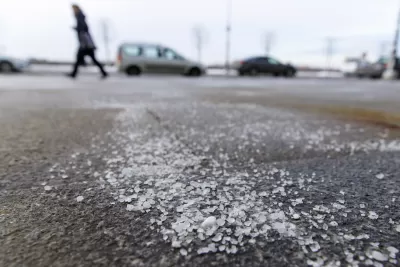Winter-oriented road design can limit the amount of polluting chloride used on the state’s roads to mitigate winter conditions.

A new road design movement in Minnesota aims to change the way we build roads and sidewalks to minimize the need for road salt, which can improve winter road conditions but also pollutes nearby water bodies with chloride. “Road salt damages vehicles, pavement and bridges, and it costs state and local governments.”
As Kirsti Marohn explains in an article for MPR News, “Low-salt design is the brainchild of Connie Fortin, a salt reduction expert who's trained more than 20,000 snowplow drivers and property maintenance workers over more than two decades.”
Developing road designs that account for where snow will pile up can reduce the need for road salt and speed up ‘pavement recovery’ without salt. For example, “Planting deciduous trees instead of coniferous along the south side of a sidewalk can reduce shadows. Designing a building so its parking lot gets full sun helps melt snow and ice quicker.”
According to Marohn, “While the design principles are voluntary right now, there’s a possibility they could become future requirements, as cities struggle to meet limits on the amount of chloride in the stormwater they are permitted to discharge into lakes and rivers.”
FULL STORY: How rethinking design could reduce the need for road salt

Alabama: Trump Terminates Settlements for Black Communities Harmed By Raw Sewage
Trump deemed the landmark civil rights agreement “illegal DEI and environmental justice policy.”

Planetizen Federal Action Tracker
A weekly monitor of how Trump’s orders and actions are impacting planners and planning in America.

The 120 Year Old Tiny Home Villages That Sheltered San Francisco’s Earthquake Refugees
More than a century ago, San Francisco mobilized to house thousands of residents displaced by the 1906 earthquake. Could their strategy offer a model for the present?

In Both Crashes and Crime, Public Transportation is Far Safer than Driving
Contrary to popular assumptions, public transportation has far lower crash and crime rates than automobile travel. For safer communities, improve and encourage transit travel.

Report: Zoning Reforms Should Complement Nashville’s Ambitious Transit Plan
Without reform, restrictive zoning codes will limit the impact of the city’s planned transit expansion and could exclude some of the residents who depend on transit the most.

Judge Orders Release of Frozen IRA, IIJA Funding
The decision is a victory for environmental groups who charged that freezing funds for critical infrastructure and disaster response programs caused “real and irreparable harm” to communities.
Urban Design for Planners 1: Software Tools
This six-course series explores essential urban design concepts using open source software and equips planners with the tools they need to participate fully in the urban design process.
Planning for Universal Design
Learn the tools for implementing Universal Design in planning regulations.
Clanton & Associates, Inc.
Jessamine County Fiscal Court
Institute for Housing and Urban Development Studies (IHS)
City of Grandview
Harvard GSD Executive Education
Toledo-Lucas County Plan Commissions
Salt Lake City
NYU Wagner Graduate School of Public Service





























